
Jasmine is a genus of shrubs and vines in the olive family (Oleaceae). It contains around 200 species native to tropical and warm temperate regions of Eurasia, Africa, and Oceania. Jasmines are widely cultivated for the characteristic fragrance of their flowers. A number of unrelated plants contain the word "jasmine" in their common names.

Allspice, also known as Jamaica pepper, myrtle pepper, pimenta, or pimento, is the dried unripe berry of Pimenta dioica, a midcanopy tree native to the Greater Antilles, southern Mexico, and Central America, now cultivated in many warm parts of the world. The name allspice was coined as early as 1621 by the English, who valued it as a spice that combined the flavours of cinnamon, nutmeg, and clove.

Metrosideros is a genus of approximately 60 trees, shrubs, and vines mostly found in the Pacific region in the family Myrtaceae. Most of the tree forms are small, but some are exceptionally large, the New Zealand species in particular. The name derives from the Ancient Greek metra or "heartwood" and sideron or "iron". Perhaps the best-known species are the pōhutukawa, northern and southern rātā of New Zealand, and ʻōhiʻa lehua, from the Hawaiian Islands.
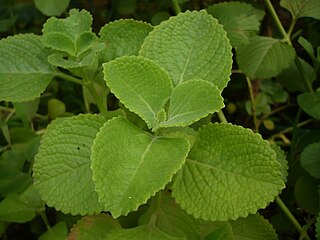
Coleus amboinicus, synonym Plectranthus amboinicus, is a semi-succulent perennial plant in the family Lamiaceae with a pungent oregano-like flavor and odor. Coleus amboinicus is considered to be native to parts of Africa, the Arabian Peninsula, and India, although it is widely cultivated and naturalized elsewhere in the tropics where it is used as a spice and ornamental plant. Common names in English include Indian borage, country borage, French thyme, Indian mint, Mexican mint, Cuban oregano, soup mint, Spanish thyme. The species epithet, amboinicus refers to Ambon Island, in Indonesia, where it was apparently encountered and described by João de Loureiro (1717–1791).
Hawaiian hibiscus are seven species of hibiscus native to Hawaii. The yellow hibiscus is Hawaii's state flower. Most commonly grown as ornamental plants in the Hawaiian Islands are the Chinese hibiscus and its numerous hybrids, though the native Hibiscus arnottianus is occasionally planted.
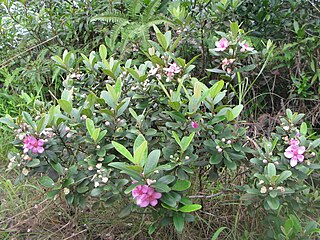
Rhodomyrtus tomentosa also known as rose myrtle, is a flowering plant in the family Myrtaceae, native to southern and southeastern Asia, from India, east to southern China, Hong Kong, Taiwan and the Philippines, and south to Malaysia and Sulawesi. It grows in coasts, natural forest, riparian zones, wetlands, moist and wet forests, bog margins, from sea level up to 2400 m elevation.
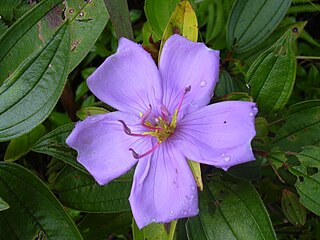
Melastoma is a genus in the family Melastomataceae. It has over 100 species distributed around Southeast Asia, India, north to Japan, south to Australia and the Pacific Islands. The number of species should probably be reduced according to some sources. Many species have been planted around the world for the aesthetic value of their bright purple flowers.

Melastoma affine, also known by the common names blue tongue or native lassiandra, is a shrub of the family Melastomataceae. Distributed in tropical and sub-tropical forests of India, South-east Asia and Australia, it is a plant of rainforest margins. Bees are the principal pollinators of this species.

Miconia crenata,, commonly called soapbush, clidemia or Koster's curse, is a perennial shrub. It is an invasive plant species in many tropical regions of the world, creating serious damage.

Tecoma capensis, the Cape honeysuckle, is a species of flowering plant in the family Bignoniaceae, native to southern Africa. Despite its common name, it is not closely related to the true honeysuckle.
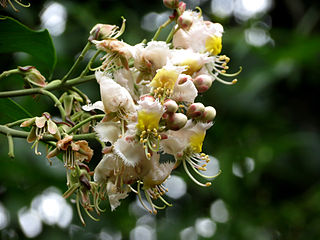
Hiptage benghalensis, often simply called hiptage, is a perennial, evergreen liana native to India, Southeast Asia, Taiwan, and the Philippines. Its habitat is variable and prefers climates ranging from warm temperate to tropical. In Hawaii, where H. benghalensis is considered a weed, as it is in Australia, Mauritius and Réunion, it grows from sea level to 1,000 m (3,281 ft). H. benghalensis is cultivated for its white-pink scented flowers.
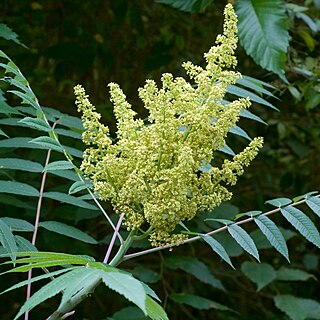
Rhus glabra, the smooth sumac, is a species of sumac in the family Anacardiaceae, native to North America, from southern Quebec west to southern British Columbia in Canada, and south to northern Florida and Arizona in the United States and Tamaulipas in northeastern Mexico.

Leptospermum lanigerum, commonly known as the woolly teatree, is a small tree or medium shrub from the plant family Myrtaceae. Its common name derives from the conspicuously hairy capsules produced as fruit, along with the fine, silky hairs present on branches and leaves. L. lanigerum is widespread in many habitats, particularly in waterlogged areas such as moist, sandy coastal heaths, on river banks, riparian scrub, woodlands and on the fringe of montane grasslands. This species is endemic to Australia, with native populations occurring in New South Wales, South Australia, Tasmania and Victoria.

Portulaca pilosa is a species of flowering succulent plant in the purslane family, Portulacaceae, that is native to the Americas. Its common names include pink purslane, kiss-me-quick and hairy pigweed. Its range extends from the southern United States and the Caribbean as far south as Brazil. It is a succulent with linear leaves and pink flowers.
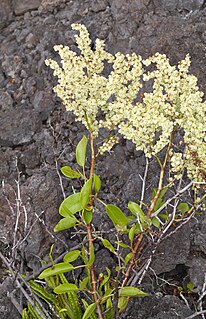
Rumex skottsbergii, or more commonly known as lava dock, is a shrub of the genus Rumex. The genus comprises approximately 200 species all derived from a single species and are therefore monophyletic. Furthermore, Rumex skottsbergii is endemic to Hawaii, where it is known as pawale. Pawale are commonly found in open lava fields that are at low elevations which range from 460-1300m. A similar plant in this genus is Rumex giganteus. Their similarity lies between their erect nature and leaves. However, the difference lies in their inflorescences. The inflorescences is described as being a cluster of flowers from the main stem axis.
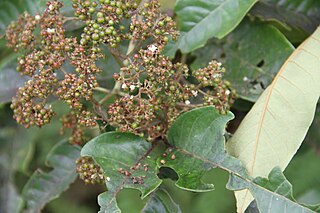
Harungana madagascariensis is a flowering plant found in Madagascar that is commonly known as the dragon's blood tree, orange-milk tree or haronga.
Dubautia pauciflorula is a rare species of flowering plant in the family Asteraceae known by the common name Wahiawa Bog dubautia. It is endemic to Hawaii where it is known only from the Wahiawa Mountains on the island of Kauai.

Melastoma malabathricum, known also as Malabar melastome, Indian rhododendron, Singapore rhododendron, planter's rhododendron and senduduk, is a flowering plant in the family Melastomataceae. This plant is native to Indomalaya, Japan and Australia, and is usually found between 100 and 2,800 m on grasslands and sparse forests. It has been used as a medicinal plant in certain parts of the world, but has been declared a noxious weed in the United States. M. malabathricum is a known hyperaccumulator of aluminium, and as such can be used for phytoremediation.
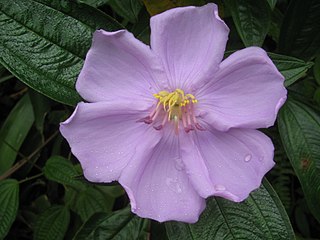
Melastoma sanguineum is called red melastome or fox-tongued melastoma in English. They are erect shrubs or small slender trees with medium-sized violet-pink colored flowers with 6 petals that have made them attractive for cultivation. The leaves have the 5 distinctive longitudinal veins (nerves) typical of plants in the family Melastomataceae.
Memecylon caeruleum is a shrub or tree species in the Melastomataceae family. It is found from New Guinea, west through Southeast Asia to Tibet, Zhōngguó/China. It has become an invasive weed in the Seychelles. It has some local use for wood and food.

















